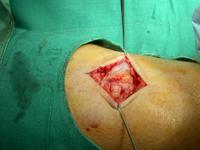All of the above factors, should be considered on examination.
I would introduce myself to the patient, ask if there was any pain and
request their permission to examine the affected part.
As the lesion is on the back of the calf, I would ask the patient to lie
prone and expose the posterior aspects of both lower limbs, so that I could
compare one with the other. I normally examine the lesion in question first
and then move on to examine the important associated structures.
On inspection, I would check if the nodule was visible, and check for
evidence of any scars in the region In particular I would look for a punctum
which is the tell-tale sign for a sebaceous cyst. I would note the colour and
appearance of the surrounding skin, to see if there was evidence of
inflammation. I would compare the two limbs, enlargement on the side with the
nodule might indicate an associated deep venous thrombosis or lymphatic
occlusion, hypertrophy of the affected limb is associated with congenital
arterio-venous malformations. If the nodule is visible I would look at it to
see if it looked like a varicose vein, or if there were associated varicose
veins raising the possibility of an area of thrombo-phlebitis. I would look to
see if the nodule was pulsating which would indicate an aneurysm, true, false
or due to an arterio-venous fistula. I would then ask the patient to plantar
flex the foot and check to see if the nodule became more or less
prominent.
Moving on to palpation, if the nodule is small and difficult to find, I
would ask the patient to indicate where it was. I would check the size, shape
and surface of the nodule and note its consistency. I would check to see if
the nodule was attached to the skin, deep fascia / muscle or bone. With
respect to the mobility of the nodule I would carefully check to see if the
mobility was restricted most when I moved the nodule from right to left or
when I moved it up and down the limb. If the nodule is not rock hard I would
check for fluctuance, this may be impossible in a small nodule, however. To
optimally check for trans-illumination, it would be necessary to examine the
patient in a darkened room.
After I have tested the mobility of the nodule, I would ask the patient if
he experienced any unusual sensations such as paresthesia. I would also
percuss the nodule with the tip of my finger to see if this induced
paresthesiae.
On auscultation I would check for a bruit.
Next I would examine the remainder of the lower limbs for evidence of other
nodules or abnormalities. I would ask the patient to lie on his back and
examine the pulses and regional lymph node basins.
Further, particular types of examination may be required depending on the
initial findings. It may be necessary to examine the patient standing up if
there is a question of venous disease. A neurological examination with
particular reference to the sural nerve would be important in
this particular patient.
Scars around the lesion are important. The nodule may represent a foreign
body. Or suture material from previous surgery.
Attachment to the skin can be easily checked by asking the patient to
relax the muscles in the leg and then moving the skin adjacent to the nodule
with one hand and observing whether this skin movement is restricted by
holding the nodule steady with the other hand.
Attachment to bone is checked for by noting that the bone and the nodule
must move together. If the bone is fixed the nodule will not move. If there is
no attachment to bone the nodule will move when the bone is fixed.
Attachment to the deep fascia and muscle is checked for by noting that
the nodule is mobile when the patient relaxes, but when they contract the
muscles the nodule becomes much less mobile or even fixed.
The significance of movement being restricted more in the up down
direction than in the left-right direction is that the nodule is most likely
attached to a structure that is running down the leg such as a nerve.
Fluctuance is checked for by checking for movement in two separate
directions when the nodule is compressed. This indicates that the structure is
fluid filled. Fat is fluid at body temperature so a lipoma may be fluctuant.
Paresthesiae on palpation or percussion of the nodule indicates that a
nerve is being stimulated.
You feel and thrill and hear a bruit. If you hear a bruit check to see if
it is continuous (machinery) or systolic. Bruits and thrills in this context
indicate an arterio-venous fistula. The bruit in an arterio-venous fistula is
continuous because there is a large pressure difference between the artery and
the vein througout the cardiac cycle and the blood flow is continuous
throughout the cardiac cycle.
Neurological examination with respect to the function of the
sural nerve is important in this patient. The nerve is lying
in the region of the nodule. If the patient looses the function of the sural
nerve post operatively, it would be nice to know if it was working normally on
clinical examination prior to surgery.
